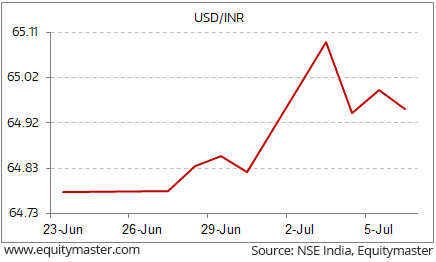- Home
- Todays Market
- Indian Stock Market News July 7, 2017
Indian Indices Trade Marginally Lower; Banking Stocks Witness Selling Fri, 7 Jul 11:30 am
Share markets in India are presently trading marginally lower. Sectoral indices are trading on a mixed note with stocks in the healthcare sector and realty sector witnessing maximum buying interest. Banking stocks are trading in the red.
The BSE Sensex is trading down 59 points (down 0.2%) and the NSE Nifty is trading down by 20 points (down 0.2%). The BSE Mid Cap index is trading up by 0.1%, while the BSE Small Cap index is trading up by 0.3%. The rupee is trading at 64.73 to the US$.
The European Central Bank (ECB) released the minutes of their latest meeting on Thursday. As per the minutes, ECB policymakers are open to a further step toward reducing their monetary stimulus. However, they are likely to move slowly on this decision out of fear of causing market turmoil.
With inflation in the euro zone slowly rebounding, the ECB is preparing to dial back its stimulus policy of ultra-low rates and massive bond purchases. However, doing so would be a challenge for the ECB after years of easy money policies.
Last month, the ECB kept interest rates unchanged in its monetary policy meet. President Mario Draghi said the ECB governing council is not convinced that the recent rebound in inflation in the eurozone is durable because wage growth remains sluggish.
Meanwhile, the bank affirmed that it intends to run its monthly net asset purchases of 60 billion euros until the end of December 2017, or beyond, if necessary.
However, the bank did not mention the possibility of further interest rate cuts. This may indicate the ECB aims to end its ultra-easy monetary policy.
The ECB has been pouring money into the eurozone to boost inflation from a near-deflationary level.
Most of the economic problems we see today are fueled by the easy money policies that central banks have adopted around the world. However, with the changes happening at central banks of late, it seems that the end of easy money is near.
In other news from currency markets, the dollar is witnessing buying interest against the rupee. This is seen ahead of the US employment data to be released today.
Gains for dollar were also seen on the back of higher US Treasury yields which rose this week amid concerns that the US Federal Reserve will begin unwinding its bond holding programme sometime this year.
Dollar Inches Upwards

While the above gains come as a respite for the dollar, one must note that the rupee has gained 6% so far this year. Most of these gains came as the dollar fell on the back of political turmoil surrounding US President Donald Trump.
On must note that the appreciation in the rupee comes as a welcome breather for importers in India. A softer rupee helps importers to buy goods and services at a cheaper rate that earlier. This is vital for a developing economy that relies heavily on imports. This bodes well for the Indian economy as higher imports normally mean increased economic activity.
But on the other hand, the rise in rupee can spell trouble for exporters. The exporters are at a disadvantage owing to the currency appreciation as this renders their produce expensive in the international markets as compared to other competing nations whose currencies haven't appreciated on a similar scale. This tends to take away a part of the advantage from Indian companies, which they enjoy due to their cost competitiveness.
Nonetheless, a stronger rupee will pull down commodity prices. This will help in keeping a tab on the rising inflation.
While there are advantages as well as disadvantages of a rising rupee, one needs to understand whether the rise in the rupee is sustainable to derive any reasonable conclusion at this stage.
For one, the weakness of the US dollar is largely due to the relative unattractiveness of US assets. This is in part due to a very low interest rate regime prevalent in the US economy. Already there are indications that this low interest rate regime may not be sustainable for long. This means that US interest rates may go up and this may likely strengthen the US dollar.
To keep a tab on the movements in rupee-dollar and other currencies, you can read the stock market commentary from the Daily Profit Hunter team. Their commentary tracks the developments in the global economy as well as stock, currency and commodity markets.
For information on how to pick stocks that have the potential to deliver big returns, download our special report now!
Read the latest Market Commentary


Equitymaster requests your view! Post a comment on "Indian Indices Trade Marginally Lower; Banking Stocks Witness Selling". Click here!
Comments are moderated by Equitymaster, in accordance with the Terms of Use, and may not appear
on this article until they have been reviewed and deemed appropriate for posting.
In the meantime, you may want to share this article with your friends!